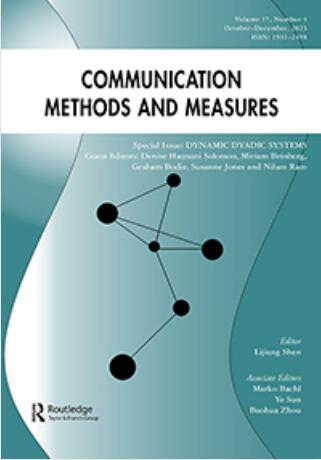非语言同步的手动和自动编码方法的比较
IF 3.7
1区 文学
Q1 COMMUNICATION
引用次数: 15
摘要
摘要受过训练的人类编码人员对非语言线索进行手动编码,例如统计特定行为的发生或对说话者的主观评价,仍然是研究非语言同步性的主要方法。然而,它的耗时性一直是该领域发展的严重障碍,并使新学者很难采用该技术。自动编码技术的最新进展使研究人员能够有效、客观地收集非语言行为数据,但尚不清楚手动和自动编码方法的可比性。因此,这项研究在面对面对话实验中直接比较了两种编码方法。在手动编码中,使用软件系统C-BAS来统计手势、姿势、点头和其他提示中同步的发生。在自动编码中,对参与者的运动数据分别进行互相关分析和跨小波相干分析。结果表明,人工编码和自动编码具有适度的相关性,并且在会话参与的实验条件下,在同步程度上产生了相似的显著差异。此外,通过两种编码技术测量的同步性与会话后的自我报告显著相关。讨论了这两种技术的优缺点。本文章由计算机程序翻译,如有差异,请以英文原文为准。
Comparing Manual and Automated Coding Methods of Nonverbal Synchrony
ABSTRACT The manual coding of nonverbal cues by trained human coders, such as counting the occurrence of a specific behavior or subjective rating about a speaker, is still a major method in the study of nonverbal synchrony. However, its time-consuming nature has been a serious barrier to the development of the field and has made it difficult for new scholars to adopt the technique. Recent advances in automated coding techniques allow researchers to collect nonverbal behavioral data effectively and objectively, but it is unclear how comparable the manual and automated coding methods are. This study, therefore, directly compared both methods of coding in a face-to-face conversation experiment. In the manual coding, a software system C-BAS was employed to count the occurrence of synchrony in gesture, posture, nodding, and other cues. In the automated coding, a cross-correlation analysis and a cross-wavelet coherence analysis were separately performed for the participant’s movement data. The results showed that the manual and automated coding were moderately correlated, and yielded similar significant differences between experimental conditions of conversational involvement in the degree of synchrony. Further, synchrony measured via both coding techniques was significantly associated with post-conversation self-reports. The advantages and disadvantages of both techniques are discussed.
求助全文
通过发布文献求助,成功后即可免费获取论文全文。
去求助
来源期刊

Communication Methods and Measures
COMMUNICATION-
CiteScore
21.10
自引率
1.80%
发文量
9
期刊介绍:
Communication Methods and Measures aims to achieve several goals in the field of communication research. Firstly, it aims to bring attention to and showcase developments in both qualitative and quantitative research methodologies to communication scholars. This journal serves as a platform for researchers across the field to discuss and disseminate methodological tools and approaches.
Additionally, Communication Methods and Measures seeks to improve research design and analysis practices by offering suggestions for improvement. It aims to introduce new methods of measurement that are valuable to communication scientists or enhance existing methods. The journal encourages submissions that focus on methods for enhancing research design and theory testing, employing both quantitative and qualitative approaches.
Furthermore, the journal is open to articles devoted to exploring the epistemological aspects relevant to communication research methodologies. It welcomes well-written manuscripts that demonstrate the use of methods and articles that highlight the advantages of lesser-known or newer methods over those traditionally used in communication.
In summary, Communication Methods and Measures strives to advance the field of communication research by showcasing and discussing innovative methodologies, improving research practices, and introducing new measurement methods.
 求助内容:
求助内容: 应助结果提醒方式:
应助结果提醒方式:


